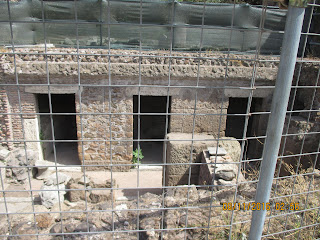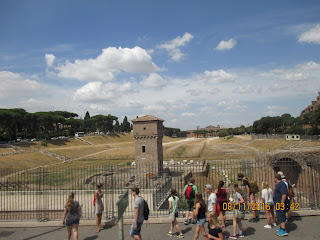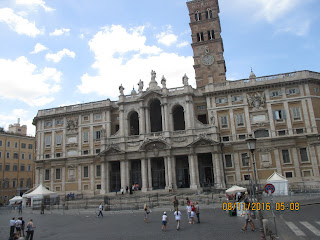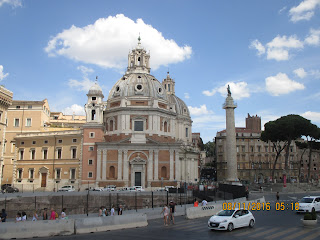Sleeping beauties in two of the four rooms so Dave and I set off to beat the heat, caught the 9:00 Hop On bus , got off at stop 3, the Colosseum.
Even though we had prepaid tickets, the line up for the entry ticket was longer than we expected. Everyone has the same idea of getting to these places early but they were very efficient, only a ten minute wait. This Colosseum is way more than I expected. My grade 11 History teacher looms before me. Mrs Woodside would be proud to know I am experiencing her passion!
Three hours of exploring inside and outside the walls of this world renowned structure. Dave loves the construction features and architectural feats. We had an opportunity to walk through the Forum and Palatino Hills as well Then the bus tour. Oh my gosh! This city has 100 fountains, the Trevi being my favourite. And all the basilicas, the Santa Maria group of four. A complete bus loop as described in Yesterday bus info.
Then home for a little rest before heading out for dinner in the Trevi area again. Yummies, this time seafood salad, all seafood, no salad once again. Sooo good. The other six had typical Italian food with some interesting desserts as well. Wine for the evening was Chianti.
Aug 12 up and on the road as a group of 8 . Caught the first bus at 9 to the Vatican, once again, skip the line ticket probably saved us two hours in a line up. Right past a very long line five people wide then into the museum first. I think that museum was a mile long, way more than any of the eight of us expected, so much history, so many artifacts and the art on the ceilings and in the tapestries was overwhelming, the sculptures un believable.
Lunch outside after some time in the Sistene Chapel, no photos allowed. The people!!! One constant stream, then asked to move to the middle, encouraged to move on. A few seats along the edge, at a premium but because this was to be our meeting place, I managed to snag a piece of marble after about twenty minutes then passed it on to C and K when they arrived. The curators were slightly upset with the lack of silence as requested and the folks who were taking photos despite all the signs and verbal reminders.
Our group parted company at this point. Dave and I hopped on bus 23 to Traverste, quaint little local area, had delicious thin crust mushroom and spinach pizza. Walked across the bridge to the island in the Tiber, saw the Hollywood set then carried on to the Pantheon where we caught our bus home, seeing those sites listed in our previous post.
Short rest then down to Termini to plan our departure in the morning. Found our bus to the airport, 6:30 am one will get us there for our flight to Marseilles. The gang returned at 7, take out pizza in our hallway and the necessity to finish numerous bottles of liquid as we all have carry on luggage!
Rome is awesome,could return here. Notes for future reference from National Geographic. I inserted "check" by the things we experienced. Rome may be a city of high fashion and expensive tastes but its rich history and art offer plenty of cultural sites that won't cost you a dime, including churches and most monuments. You don't have to look far for free activities in the Eternal City. Attractions Built between A.D. 118 and 125 as a temple honoring the Roman gods, the Pantheon was converted in 609 to a Roman Catholic church. The architect Filippo Brunelleschi used it as inspiration when designing the cupola for the Duomo (cathedral) in Florence. Its most striking feature is the oculus, an open-air aperture at the top of the dome that lets in natural light. Several Italian kings and famous artists, including Raphael, are buried here. Admission is free. Guided tours are available for about $12; a cheaper alternative (starting at $1.50) is the Pantheon iVIEW app for iPhones and iPads. Mass is held on Saturdays at 5 p.m. and public holidays at 10:30 a.m. "Check" The Arco di Constantino, located near the Colosseum, is Rome's largest arch. About 65 feet high, it was built in A.D. 315 to commemorate Emperor Constantine's triumph over Maxentius, after which he allowed the practice of Christianity in the Roman Empire. "Check" Looming over Piazza Venezia, the imposing Il Vittoriano honors Victor Emmanuel II, the first king of unified Italy, who is depicted astride a horse on a statue atop the white marble monument. The “wedding cake,” as locals refer to it, houses a museum, which details Italian unification, as well as a gallery space and the Tomb of the Unknown Soldier. "Check" Test your luck at La Bocca della Verità ("the mouth of truth"). This grotesque sculpture of a wild-eyed face on the portico of the Church of Santa Maria in Cosmedin has a macabre reputation made famous by Gregory Peck and Audrey Hepburn in the 1953 film Roman Holiday. Legend has it that if you put your hand in its gaping mouth and tell a lie, you'll pull out nothing but a stump. "Check" Walk off that gelato on the Spanish Steps, the longest and widest staircase in Europe. Originally proposed by the French, this grand staircase leads from the Piazza di Spagna to the Trinità dei Monti Church (they became the "Spanish" steps after the Spanish Embassy moved to the square). Once a hangout for artists, the steps are now abuzz with students, tourists, shoppers, and portrait sketchers. "Check" The world center of the Catholic Church, St. Peter's Basilica is also an astounding work of art. Entry to the main floor is free. The outside colonnade and the 90-foot baldacchino—the staggering bronze canopy that shelters the papal altar, where only the pope may celebrate Mass—were designed by Gian Lorenzo Bernini, one of the greatest baroque sculptors. Don't miss the "Pietà," one of Michelangelo's most famous statues (now sheltered behind glass after an attack by a hammer-wielding maniac), and make sure to rub St. Peter's well-worn foot for good luck as you pass his bronze statue. Prepare to wait in line; crowds thin slightly on Tuesdays and Thursdays after 2 p.m. There is a roughly $9 charge to climb up to the dome, designed by Michelangelo. San Clemente, a church on Via San Giovanni, harbors three churches in one. The lowermost level contains a mithraeum, an ancient worship site; this is the best preserved of 12 similar sites discovered in Rome. Above the mithraeum is the first version of the church as a Christian worship site, with a sanctuary dating to the fourth century. The fresco depicting St. Sisinus dates to between the 8th and 11th centuries. The top level is home to a sanctuary built in the 12th century that contains some spectacular mosaics. Culture Make the most of the first Sunday of each month, when public museums, monuments, and archaeological sites are free for all visitors. See the vast collection of art in the Vatican Museums, including the Sistine Chapel, for free on the last Sunday of every month from 9 a.m. to 2 p.m. (last admission is at 12:30 p.m.). The 16th-century Gallery of the National Academy of San Luca houses works by members of the academy, including baroque painter Guido Reni. Admission is free. The onetime command post of the German SS, the free Historic Museum of the Liberation of Rome (Museo Storico della Liberazione) chronicles events in Rome during the Nazi occupation. Visitors can also see graffiti by leaders of the Roman Resistance, who were imprisoned and tortured here. See more than 20,000 artifacts on display and learn about former and current moneymaking techniques at the Numismatic Museum of the Italian Mint. Show your I.D. to obtain the free entrance pass. Rome's national museums and other major galleries have deals that change constantly. Check with museums individually before you go for any special admission prices. Families At Park Gianicolo on Janiculum Hill, families can enjoy a panoramic view of Rome and several activities. One of the biggest attractions in this park is the Teatro Verde’s free puppet show, a centuries-old European tradition, performed daily. Although most shows are in Italian, children from all nationalities enjoy the puppets' antics, which transcend language barriers. Children might want to check out the only pyramid in Rome, an 87-foot-tall structure built to house the tomb of Caius Cestius in 12 B.C.—after Cleopatra made Egyptian style chic. One of the best preserved ancient buildings in Rome, it even has its own metro stop (Piramide). Visit the cats at Torre Argentina Cat Sanctuary, where they lounge and frolic among the ruins of four ancient temples. Donations and long-distance cat adoptions are welcome. In addition to the temples, this area houses another key part of history: It was near here that Julius Caesar was stabbed to death by Brutus in 44 B.C. Visit the gardens at Villa Borghese. One of the most expansive and beautiful gardens in Rome, this park is a great place to stop for a picnic; adults can relax and kids can explore. The adjoining Galleria Borghese is worth a visit, especially on the first Sunday of each month, when admission is free. Or you can try Villa Sciarra, which has a playground located next to an exotic-bird aviary. You can feed the birds if you bring your own bread. And at Villa Ada, several organizations (such as the World Wildlife Fund) offer free activities for children. It also features a playground, merry-go-round, and roller skating track. Older children will love the crypt of Capuchin friars in Santa Maria della Concezione, a monastery where, since 1631, the walls and ceilings have been elaborately decorated with the bones of some 4,000 monks. Chase nymphs in Caffarella. This valley, extending from the south to the center of Rome, is a unique natural area where you can come across anything from chic city Romans on a stroll to herders guiding sheep. You can even find yourself alone in this expanse of fields that shelters the ruins of old Roman houses and temples. Children will be intrigued by the magical history of this area, where in ancient times rituals were often held. One of the best preserved ruins is dedicated to the nymph Egeria; legend has it that she lives in the roadside temple. Watch the blessing of the animals (benedizione animali), a tradition dating to the eighth century and held yearly on or around January 17 at the Church of Saint Eusebio. On this day, hundreds of citizens come to have their pets blessed by a priest; animals include everything from cats and dogs to fish and lizards. Or you can watch the blessing of the cars in March at the Santa Francesca Romana Church, located near the Colosseum. Food/Drink A Rome institution known for its antipasto, Hostaria Romana offers diners free cookies, grappa, and after-dinner limoncello. Brunello offers National Geographic readers a free glass of Italian prosecco with an appetizer. Several restaurants and hotels offer complimentary aperitivo (happy hour) appetizers (with drinks at regular prices), including Enoteca Ferrara and the bar in the Ludovisi Palace Hotel, a popular spot with the locals. Outdoors Piazza di Spagna, one of the most well-known piazzas in Rome, was once home to Romantic poet John Keats, who died in an apartment that looked onto the square (his quarters are now a museum). The square also sports the famous Fontana della Barcaccia ("fountain of the boat"), designed by Pietro Bernini and his son Gian Lorenzo Bernini. The window-shopping around the Piazza di Spagna is some of the best in Rome. "Check" Designed by Niccolo Salvi, the Fontana di Trevi is perhaps the most famous in Rome. The fountain was completed in 1762 and is the largest and most intricate of the baroque fountains of Rome, combining sculpture, nature, and architecture. Legend has it that if you throw a coin in over your shoulder, you will return to Rome. "Check" Originally a center for sporting events (including horse races), Piazza Navonalater became the location of a major market. The main market has since moved to Campo de' Fiori, but the piazza is still a central location for street fairs, parades, and other events. It also contains some of Rome's most famous artwork: Borromini and Rainaldi's Sant'Agnese in Agone Church and Gian Lorenzo Bernini's Fountain of the Four Rivers (Fontana dei Fiumi), where each figure represents one of the four main rivers known at the time—the Nile, the Ganges, the Danube, and the Rio de la Plata. Two other fountains on the square, the Fontana di Nettuno and the Fontana del Moro, were designed by Giacomo della Porta. "Check" The Campo de' Fiori is known for its morning flower and vegetable market and its evening bar and restaurant scene. The name, given in the Middle Ages, means "field of flowers," referring to the fact that the square was once a meadow For an authentic Roman walk, stroll through the trendy neighborhood of Trastevere. This area's narrow streets and numerous squares are reminiscent of classical Roman and medieval times. Once the home of artisans, fishermen, and merchants, Trastevere became known for its immense villas and beautiful gardens, which belonged to Julius Caesar. After hours, the area is known for its nightlife. "Check" Starting at 7 p.m. every night, Irish-operated Angel Tours offers a free 30-minute tour of the Pantheon in small groups. Show up at the Pantheon and look for the tour guides holding umbrellas with angels on them. On Sundays, the tour explores the outside of the Pantheon, as it closes at 6 p.m. If coming with a large group, book ahead. Tips are welcome. Theater/Music Throughout September's International Urban Theater Festival, keep your eyes open for spontaneous dance, music, and acting performances throughout the city. All of Rome becomes a stage during Estate Romana, the main summer festival, dedicated to outdoor performances. Hundreds of concerts, film showings, dances, and art displays are staged, many of them free to the public. Spend a warm evening listening to a blues concert on the steps of a palazzo or watching a theater performance among the ancient ruins at Ostia Antica. On the Feast of the Assumption (August 15), the streets come alive with dance for the Gran Ballo di Ferragosto. Piazzas become a stage for professional dancers to show off their skills, with each square in Rome home to a different dance performance: hip-hop, tango, ballroom, and more. Spectator participation is encouraged. Watch the Miracle Players at the Forum. This English-language cosmopolitan theater troupe, recognized by the Italian Ministry of Culture for its funny and original plays, offers free public performances at the Roman Forum throughout the summer.



































































































































































No comments:
Post a Comment